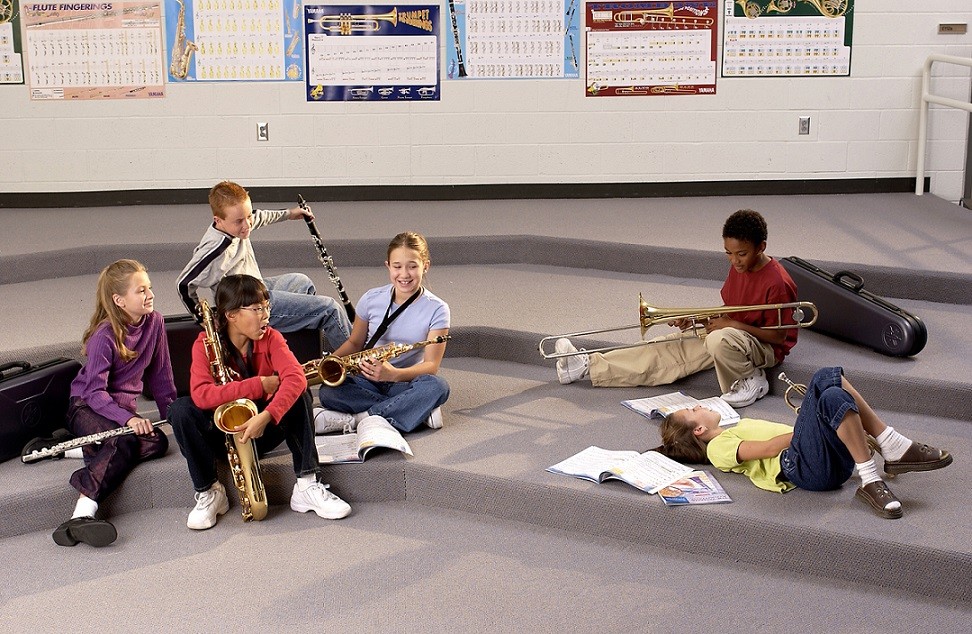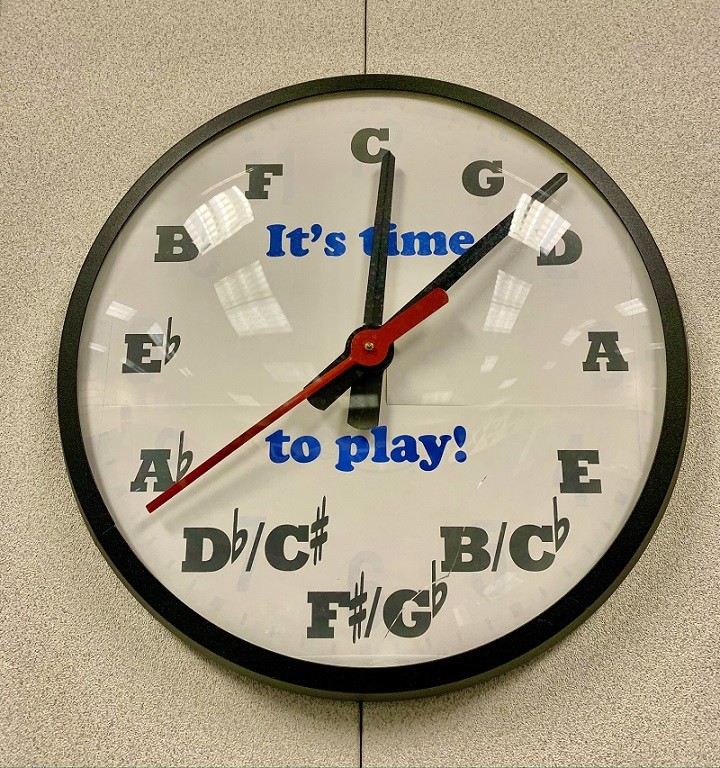Tagged Under:
5 Major Assets of Teaching Instrumental Music
Protect the five non-negotiables assets of teaching instrumental music — students, instruments, facilities, literature and time.
When we jump into the school year, we’re often forced to just start planning curriculum and deal with the course of events that gets in the way. We don’t have time to take a good look at what we need or already have to work with.
But it’s essential and a valuable exercise to take inventory of what our available assets are — whether you do this at the beginning of the year, mid-year or at the end of the school year.
There are some assets in instrumental music education that are absolute non-negotiables — our “must haves.” I call these major assets, and they include students, instruments, facilities, literature and time. Here is a one-page chart that outlines these major assets.
Major Asset #1: Students — “My students are driving me crazy!”
Okay, you know your students have just been through (as have you) a global pandemic and maybe a year of distance learning. Their lives still aren’t anywhere near normal with many areas requiring masks, following many restrictions and suffering from supply-chain issues.
The point here is that you still have students! Students are our No. 1 asset because we can’t teach empty chairs. Are their moods and behavior wonkier than usual? Of course! But we know this, and we can work with it.
The key to protect this top asset is basic Maslow — students’ physical, emotional and social needs must be met first for their intellectual and musical knowledge to develop best.
 Is the environment in your room comfortable, clean and inviting, or is it dark and dirty, with instrument parts and random reams of music sheets stacked everywhere (no, I haven’t been looking in your room!)? A room that is physically inviting welcomes students, and it becomes their favorite place to be (until you kick them out).
Is the environment in your room comfortable, clean and inviting, or is it dark and dirty, with instrument parts and random reams of music sheets stacked everywhere (no, I haven’t been looking in your room!)? A room that is physically inviting welcomes students, and it becomes their favorite place to be (until you kick them out).
Are you developing routines so that your students can become re-accustomed to getting water, using the restroom and eating, or do these interruptions plague your rehearsals? These are basic physical needs that many of our kids haven’t had to time manage in a while, so you’ll need to help them by utilizing a routine or system.
We hear this a lot lately, but are you checking in with your students to see how they’re feeling emotionally? Band is such a great opportunity for students to receive daily encouragement, a pat on the back, spontaneous applause and positive recognition. Make these things a part of your daily rehearsal!
It’s also important to include time for peer-to-peer interaction, which helps develop a positive social class culture. Do your students regularly share knowledge with each other? Even a daily interaction question like “What’s your favorite animal?” sparks discussion and collaboration. Building this small social skill can have a huge positive effect on your students’ happiness in your class. With a positive class culture, you can more easily develop your students’ intellectual and musical needs.
Major Asset #2: Instruments — “Instrument problems slow me down every day!”
During the pandemic, we all have taught kids how to hold a trombone or a flute via Zoom. A year of learning through a screen has created some interesting habits, and left some instruments uncared for and unused.
Instruments are our second most important asset because if they don’t work, we can’t play! I had to go through way more stuck valves and slides than usual when instruments were issued this year. This byproduct of our COVID-19 virtual year prompted me to start teaching my kids an even more specific regimen of daily/weekly care. A relatively small investment in time each day will help keep your instruments out of the shop, which is way cheaper than repairing them!
In many cases, we’re charged with an inventory of the most expensive, fragile, hardest to repair and oldest pieces of equipment on campus. It’s in your best interests to be keenly aware of the condition of every instrument, whether school or student owned. Proper storage of your instruments is one of the best ways to protect these valuable assets. Too many times, I’ve heard someone complain about the condition of their one-and-only tuba, only to see that it’s being stored on its bell on the floor in a corner of the room.
Major Asset #3: Facilities — Student: “What’s being in band like?” Band kid: “It’s in tents”
At my school, Lexington Junior High School in Cypress, California, until recently, we’ve been literally in a tent city of pop-up canopies. My students and I now know the exact pitches of a lawnmower, weed whacker, leaf blower and the backup beeping of a trash truck. I can’t wait to go back to our all-important indoor facilities!
 Developing routines and systems for entry/exit and storing instruments are vital to keep our class transitions smooth. And even outside, taking the time for things like making sure chairs aren’t broken and music stands are tight helps reduce distractions, which makes rehearsals more efficient.
Developing routines and systems for entry/exit and storing instruments are vital to keep our class transitions smooth. And even outside, taking the time for things like making sure chairs aren’t broken and music stands are tight helps reduce distractions, which makes rehearsals more efficient.
As our band “home,” facilities are one of our top three most important assets. While they don’t need to be fancy, facilities do need to be functional. Even though some of these environmental challenges are out of the director’s hands, there are some things we can control. For example, is your room set up to be efficient? Part of the efficiency of a working band room includes having a place for everything (bins, drawers, files, etc.), an established flow of “traffic” in, out and around the room, and tools and materials that are easily accessible to students. Is it welcoming? A well-lit, colorful room invites students in, and stimulates creativity. Is it neat and orderly?
A regular regimen of picking up, straightening chairs and stands, throwing out old/unused papers can often be accomplished by just asking students to volunteer for a “position” in band leadership. I can’t tell you how many band rooms I’ve entered that look like a bomb just went off (don’t immediately blame the percussion section). I’ve also walked into some band rooms that immediately inspired me to step up my own organizational skills. Students’ behavior and attitude will often mirror their environment.
Major Asset #4: Literature — “If you could only have one food for the rest of your life, what would it be?”
 Without hesitation, my answer would be tacos. But what if the question was “What music could you listen to for the rest of your life?” I can’t answer that one right away because I listen to a lot of different things. And like my culinary palette, I’m glad that my musical tastes have been and continue to be shaped by exposure to many different genres and artists (or regional and international cuisines).
Without hesitation, my answer would be tacos. But what if the question was “What music could you listen to for the rest of your life?” I can’t answer that one right away because I listen to a lot of different things. And like my culinary palette, I’m glad that my musical tastes have been and continue to be shaped by exposure to many different genres and artists (or regional and international cuisines).
Each year, our band members have the opportunity to read through and perhaps perform anywhere from a dozen to 30 pieces of music. Our choice of literature is our students’ musical “diet,” and while not every piece must be of the highest aesthetic and intellectual value, each one must serve a purpose in furthering students’ musical ability, understanding or enjoyment.
This is a huge responsibility to be charged with, and one we can’t take lightly. When selecting music for your students, ask the following questions:
- Can you and your students listen to this piece many, many times?
- Does it teach or reinforce a new or important concept?
- Does it add to the students’ knowledge base?
- Is it readable (at an appropriate level)?
- Is it relevant?
- Will it stand up to the test of time?
While we all might give in during a moment of weakness and pass out the latest pop hit, quality literature that will always hold up to these criteria must be the staple of our students’ musical diet.
As our fourth asset, musical literature must be carefully curated and handled. Do you have a system for passing out, collecting and storing music? (No, stacking is not a system.) Personally, I use large roll-out drawers and numerically organized boxes for long-term storage, with pieces we’re currently working on kept in a more accessible file drawer. What’s your system for keeping music literature organized — email us at educators@yamaha.com.
Major Asset #5: Time — “Does anybody really know what time it is? Does anybody really care?”
 There are no numbers on the clock in my room, only a circle of fifths. So, our school day begins just before “F” and ends at almost “half-past D.”
There are no numbers on the clock in my room, only a circle of fifths. So, our school day begins just before “F” and ends at almost “half-past D.”
The last of our major assets is free, but it is also limited. In fact, there is only a specific amount of it for us to use each day. Our time with our students is priceless, and I know we all fight for every minute we can get. Our student time can be structured (planned lesson time, performances, etc.) or unstructured (setting up time, end of rehearsals, after-school practice sessions, etc.), but it should always be goal-centered. Even for those band directors who feel comfortable winging it, they will find that their productivity increases when they have a more specific plan. Your program’s success will increase even more when those plans are tied into long-range goals that are specific and sequential.
These goals might include reading rhythms up to a certain value, playing pitches within a specific range for each instrument, demonstrating a specific level of understanding of musical expression via performance, being able to comment on the cultural relevance of a musical idea, etc. Are you building on these goals as part of your daily process?
Time is a constant factor in our daily lives, but so is change. We are at a stage on my campus where “normal” now includes special schedules, events, interruptions and the like. For this reason, your use of time must also be flexible. Being able effectively cut, go on, or table something for tomorrow is almost as useful as the planning itself.
Knowing and utilizing these major assets could improve your program and go a long way toward reducing your stress level and add to your longevity. Take a personal inventory of your assets — are you making the most of them?
In the article, “5 Minor Assets to Running a Successful Music Program,” I look at five secondary — or minor — assets that directors rely on to run an effective music program.
















